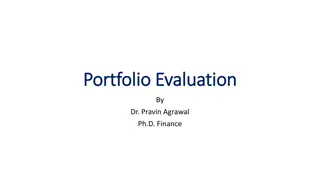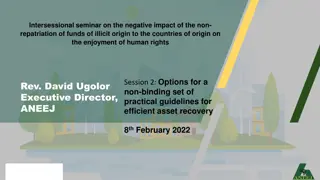Understanding Asset Allocation and Portfolio Management
Explore the process of asset allocation, which involves distributing wealth among different countries and asset classes for investment purposes. Learn about asset classes, the components of structured portfolio management processes, and the individual investor life cycle stages. Dive into strategies for constructing portfolios, monitoring performance, and adapting to changing financial conditions to meet investor needs effectively.
Download Presentation

Please find below an Image/Link to download the presentation.
The content on the website is provided AS IS for your information and personal use only. It may not be sold, licensed, or shared on other websites without obtaining consent from the author. Download presentation by click this link. If you encounter any issues during the download, it is possible that the publisher has removed the file from their server.
E N D
Presentation Transcript
Asset allocation Process of deciding how to distribute an investor s wealth among different countries and asset classes for investment purposes.
Asset allocation Asset class comprises of securities with similar characteristics, attributes, and risk/return relationships. For example, a broad asset class could be bonds which can be divided into smaller asset classes like treasury bonds, corporate bonds, etc
Asset allocation Component of a structured four-step portfolio management process Investor can range from an individual to trustees overseeing a corporation s billion- dollar pension fund, a university endowment or an insurance company portfolio.
The Portfolio Management Process 1. Policy statement - Focus: Investor s short-term and long- term needs, familiarity with capital market history, and expectations 2. Examine current and project financial, economic, political, and social conditions - Focus: Short-term and intermediate-term expected conditions to use in constructing a specific portfolio 3. Implement the plan by constructing the portfolio - Focus: Meet the investor s needs at the minimum risk levels 4. Feedback loop: Monitor and update investor needs, environmental conditions, portfolio performance
Individual investor life cycle Financial plans and investment needs depends on Investor s age Financial status Future plan Risk aversion characteristics Needs
Individual Investor Life Cycle Accumulation phase early to middle years of working career Consolidation phase past midpoint of careers. Earnings greater than expenses Spending/Gifting phase begins after retirement
Individual Investor Life Cycle Net Worth Accumulation Phase Consolidation Phase Spending Phase Gifting Phase Long-term: Retirement Long-term: Retirement Long-term: Planning Estate Short-term: Children s college Vacations Short-term: Short-term: House Car Children s College Lifestyle Needs Gifts Age 25 35 45 55 65 75
Accumulation phase Early to middle years of working career Attempts to accumulate assets to satisfy immediate needs for example for house down payment Longer term goals children s college education, retirement
Accumulation phase Net worth is small Debt from car loans or her college loan heavy Long investment time horizon and their future earning ability Willing to make relatively high-risk investments in the hopes of making above-average nominal returns over time
Consolidation phase Midpoint of career Paid of much or all of outstanding debts Have assets to pay children s college bills
Consolidation phase Earnings exceeds expenses Excess invested for retirement needs Capital preservation required Moderately high risk investment
Spending phase After retirement Living expenses covered by income from earlier investments Need to protect capital from inflation Investments less risky than consolidation phase but risky enough to compensate inflation
Gifting phase Sufficient income and assets to cover their current and future expenses Reserve for meeting uncertainties Excess assets to provide financial assistance to relatives or friends
Life Cycle Investment Goals Near-term, high-priority goals Long-term, high-priority goals Lower-priority goals
1. Policy statement Specifies investment goals and acceptable risk levels Should be reviewed periodically Guides all investment decisions
2. Study current financial and economic conditions and forecast future trends Determine strategies to meet goals Requires monitoring and updating
3. Construct the portfolio Allocate available funds to minimize investor s risks and meet investment goals
4. Monitor and update Evaluate portfolio performance Monitor investor s needs and market conditions Revise policy statement as needed Modify investment strategy accordingly
The Need For A Policy Statement Helps investors understand their own needs, objectives, and investment constraints Sets standards for evaluating portfolio performance Reduces the possibility of inappropriate behavior on the part of the portfolio manager
Constructing A Policy Statement Questions to be answered: What are the real risks of an adverse financial outcome, especially in the short run? What probable emotional reactions will I have to an adverse financial outcome? How knowledgeable am I about investments and the financial markets?
Constructing A Policy Statement What other capital or income sources do I have? How important is this particular portfolio to my overall financial position? What, if any, legal restrictions may affect my investment needs? What, if any, unanticipated consequences of interim fluctuations in portfolio value might affect my investment policy?
Investment Objectives Risk Tolerance Absolute or relative percentage return General goals
Investment Objectives General Goals Capital preservation minimize risk of real loss Capital appreciation Growth of the portfolio in real terms to meet future need Current income Focus is in generating income rather than capital gains
Investment Objectives General Goals Total return Increase portfolio value by capital gains and by reinvesting current income Maintain moderate risk exposure
Investment Constraints Liquidity needs Vary between investors depending upon age, employment, tax status, etc. Time horizon Influences liquidity needs and risk tolerance
Investment Constraints Tax concerns Capital gains or losses taxed differently from income Unrealized capital gain reflect price appreciation of currently held assets that have not yet been sold
Investment Constraints Tax concerns Realized capital gain when the asset has been sold at a profit Trade-off between taxes and diversification tax consequences of selling company stock for diversification purposes
Legal and Regulatory Factors Limitations or penalties on withdrawals Fiduciary responsibilities - prudent man rule Investment laws prohibit insider trading
Unique Needs and Preferences Personal preferences such as socially conscious investments could influence investment choice Time constraints or lack of expertise for managing the portfolio may require professional management
Unique Needs and Preferences Large investment in employer s stock may require consideration of diversification needs Institutional investors needs
Constructing the Policy Statement Objectives - risk and return Constraints - liquidity, time horizon, tax factors, legal and regulatory constraints, and unique needs and preferences Developing a plan depends on understanding the relationship between risk and return and the importance of diversification
The Importance of Asset Allocation An investment strategy is based on four decisions What asset classes to consider for investment What normal or policy weights to assign to each eligible class Determining the allowable allocation ranges based on policy weights What specific securities to purchase for the portfolio
The Importance of Asset Allocation According to research studies, most (85% to 95%) of the overall investment return is due to the first two decisions, not the selection of individual investments
Returns and Risk of Different Asset Classes Historically, small company stocks have generated the highest returns. But the volatility of returns have been the highest too Inflation and taxes have a major impact on returns Returns on Treasury Bills have barely kept pace with inflation
Returns and Risk of Different Asset Classes Measuring risk by probability of not meeting your investment return objective indicates risk of equities is small and that of T-bills is large because of their differences in expected returns Focusing only on return variability as a measure of risk ignores reinvestment risk
Asset Allocation Summary Policy statement determines types of assets to include in portfolio Asset allocation determines portfolio return more than stock selection
Asset Allocation Summary Over long time periods, sizable allocation to equity will improve results Risk of a strategy depends on the investor s goals and time horizon
Asset Allocation and Cultural Differences Social, political, and tax environments influence the asset allocation decision Equity allocations of U.S. pension funds average 58% In the United Kingdom, equities make up 78% of assets In Germany, equity allocation averages 8% In Japan, equities are 37% of assets
Summary Identify investment needs, risk tolerance, and familiarity with capital markets Identify objectives and constraints Enhance investment plans by accurate formulation of a policy statement Focus on asset allocation as it determines long-term returns and risk
Objectives and Constraints of Institutional Investors Mutual Funds pool investors funds and invests them in financial assets as per its investment objective
Pension Funds Receive contributions from the firm, its employees, or both and invests those funds Defined Benefit promise to pay retirees a specific income stream after retirement Defined Contribution do not promise a set of benefits. Employees retirement income is not an obligation of the firm
Endowment Funds They represent contributions made to charitable or educational institutions
Insurance Companies Life Insurance Companies earn rate in excess of actuarial rate growing surplus if the spread is positive fiduciary principles limit the risk tolerance liquidity needs have increased tax rule changes
Insurance Companies Nonlife Insurance Companies cash flows less predictable fiduciary responsibility to claimants Risk exposure low to moderate liquidity concerns due to uncertain claim patterns regulation more permissive
Banks Must attract funds in a competitive interest rate environment Try to maintain a positive difference between their cost of funds and their return on assets Need substantial liquidity to meet withdrawals and loan demands Face regulatory constraints























